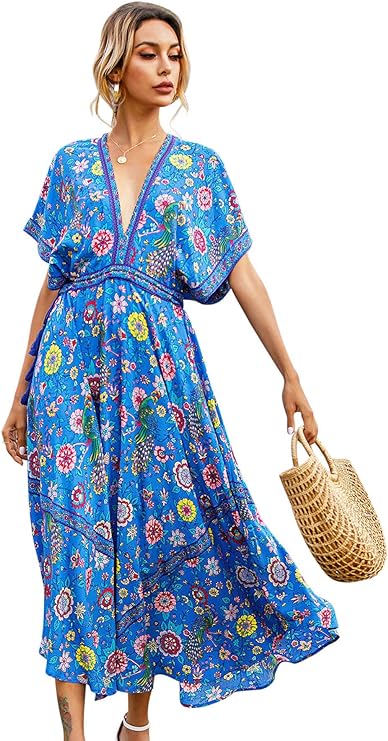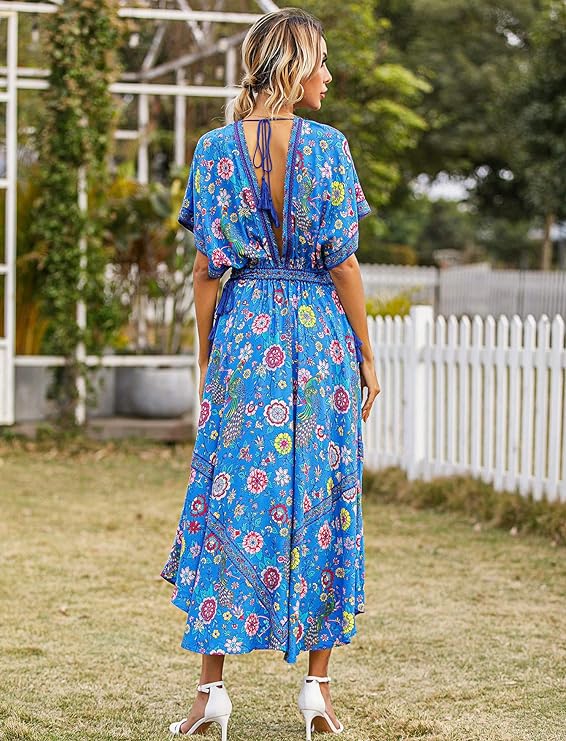1. Introduction to the Kimono Dress
The kimono dress, with its origins deeply rooted in Japanese culture, has transcended its traditional boundaries to become a significant influence in global fashion trends. Initially worn as a formal attire in Japan, the kimono has evolved from its conventional form to a more contemporary variant known commonly as the kimono dress. This adaptation preserves the essence of its heritage while infusing modern elements that appeal to a broader audience. The allure of the kimono dress lies in its versatility, ability to blend tradition with modernity, and the unique aesthetic it offers. As we delve into the resurgence of the robe kimono, we explore its historical significance, its reinterpretation in contemporary fashion, and the implications of this blend on cultural identity and fashion innovation.

2. Historical Significance and Evolution
Historically, the kimono was more than just attire; it symbolized Japanese culture, social status, and personal identity. The intricate designs, patterns, and colors of traditional kimonos conveyed information about the wearer’s age, marital status, and seasonality. However, the shift from traditional kimonos to kimono dresses signifies a remarkable transition in fashion, where practicality and style converge. The evolution of the kimono dress represents a bridge between the past and the present, enabling wearers to honor their heritage while embracing contemporary fashion sensibilities. This transition has not only impacted the perception of the kimono globally but has also contributed to sustainability by reintroducing traditional fabrics and styles in modern contexts.
Historical Significance and Evolution
The kimono, traditionally made of silk, symbolizes various aspects of Japanese culture, including social status, personal identity, and the changing seasons. Originally, its complex structure and intricate designs were reserved for the elite, making it a coveted symbol of wealth and power. However, as Japan opened its doors to the world, the kimono began to influence global fashion designers, who were fascinated by its beauty and symbolism. This marked the beginning of the kimono’s gradual transformation into a more accessible and versatile garment, leading to the advent of the kimono dress in modern fashion.

Furthermore, the adaptation of the kimono into casual and formal dresses has made it a staple in contemporary wardrobes worldwide. Designers have reimagined the traditional kimono, incorporating its aesthetic and functional elements into dresses that appeal to a global audience. This has not only broadened the kimono’s appeal but has also sparked conversations about cultural appropriation versus appreciation in fashion.
3. The Contemporary Fashion Scene
In contemporary fashion, the kimono dress has been enthusiastically adopted by designers and fashion houses, intrigued by its unique silhouette and the narrative behind its design. Today, kimono dresses are not confined to traditional materials; they are created with a variety of fabrics, from silk to cotton, and even synthetic blends, catering to different tastes and occasions. High-end fashion shows often feature kimono dresses that push the boundaries of the traditional design, incorporating avant-garde elements that challenge the conventional perception of what a kimono can be. This fusion of traditional and contemporary elements has made the kimono dress a beloved choice for both casual wear and formal occasions, highlighting its adaptability and enduring appeal.

4. Cultural Appreciation vs. Appropriation
The global embrace of the kimono dress raises important questions about cultural appreciation versus appropriation. It is essential to approach the design and wear of kimono dresses with sensitivity and respect for their cultural origins. Designers incorporating kimono elements into their creations should strive to acknowledge the history and significance of the garment. By fostering an understanding and appreciation of the kimono’s cultural background, the fashion industry can celebrate the beauty of the kimono dress without diminishing its value or meaning. Consumers, too, play a role in this dynamic, by choosing to wear kimono dresses that honor and respect the traditions from which they derive.
5. The Role of the Kimono Dress in Fashion Innovation
The kimono dress stands as a testament to the power of fashion innovation, seamlessly merging historical elements with modern needs. This garment challenges the fashion industry to think creatively about how traditional attire can be reimagined for contemporary markets. It also promotes the idea that fashion can be a platform for cultural exchange, where ideas and inspirations from various backgrounds converge to create something new and exciting. The kimono dress not only inspires designers to explore the potential within cultural heritage but also encourages consumers to broaden their fashion horizons, embracing styles that tell a story and have a deeper meaning.

The Kimono Dress in Modern Fashion
The kimono dress, characterized by its T-shaped design, loose fit, and wide sleeves, has seen numerous iterations in the fashion industry. From high-end fashion runways to mainstream retail stores, the kimono dress has been celebrated for its elegance and comfort. Designers have experimented with fabrics, prints, and cuts to create pieces that range from sophisticated evening wear to casual summer dresses, demonstrating the versatility of the kimono silhouette.
Moreover, the integration of sustainable practices into the creation of kimono dresses is a testament to the garment’s adaptability to contemporary values. By repurposing vintage kimonos or employing eco-friendly materials, fashion designers are honoring the traditional aspect of the kimono while making a statement about the importance of sustainability in fashion.
Cultural Significance and Global Influence
The widespread adoption of the kimono dress serves as a bridge between traditional Japanese culture and global fashion enthusiasts. By wearing a kimono dress, individuals can celebrate and participate in a cultural exchange that enriches their understanding of Japanese tradition and its aesthetic principles, such as harmony, simplicity, and the beauty of nature.
However, the kimono dress’s popularity also raises questions about cultural appropriation. It’s crucial for fashion designers and consumers to approach the garment with respect and awareness, ensuring that its use celebrates and honors its cultural origins rather than exploiting them. The global appreciation of the kimono dress has the potential to foster a deeper appreciation for cultural diversity in fashion, promoting a more inclusive and respectful industry.

6. Conclusion: The Future of the Kimono Dress
The journey of the kimono dress from traditional garment to a staple in modern wardrobes exemplifies the dynamic nature of fashion. As it continues to evolve, the kimono dress will undoubtedly adapt to changing trends, technologies, and cultural influences. However, its essence—rooted in the appreciation of beauty, simplicity, and respect for tradition—will remain a constant. The future of the kimono dress is bright, promising further innovation and creative interpretation, bringing together people from all walks of life to celebrate the rich tapestry of global cultures through fashion. As we move forward, the kimono dress will continue to embody the marriage of tradition and modernity, offering endless possibilities for expression and connection in the increasingly interconnected world of fashion.

